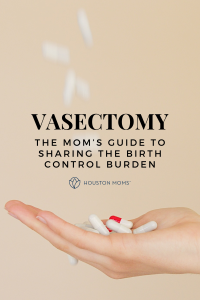Family planning is an important aspect of our lives as mothers. Traditionally, moms have carried the lion’s share of the birth control burden, from swallowing pills, wearing patches, getting injections, all the way to using various implanted devices. But what if I told you there’s a birth control option that doesn’t involve us for once?
{Disclaimer: The information below is meant to provide a general overview of the vasectomy procedure. The process may vary by physician, clinic, and location. Always consult with your healthcare provider with any questions you may have.}
What’s a Vasectomy?
A vasectomy is a permanent form of male birth control that involves surgically cutting the tubes {the vas deferens} that carry sperm from the testicles. This simple procedure ensures that sperm can’t mix with semen, rendering a man sterile. It’s like putting up a “No Entry” sign on the highway that carries sperm from the testicles. Yes, it’s the ultimate detour for those little swimmers.
What are its benefits? Well, similar to female sterilization methods {which is a tubal ligation}, a vasectomy is equally effective at preventing pregnancies, with a success rate of over 99%. A vasectomy is a relatively quick and minimally invasive surgical procedure. It’s usually done as an outpatient procedure, requiring as little as one small incision {depending on your surgeon} and local anesthesia.
The Burden of Birth Control on Women
Traditionally, women have borne the primary responsibility for birth control. Ladies, you know the drill. The pill, the patch, the IUD, the shot—you name it. This imbalance has real consequences. Women often experience side effects and challenges related to using hormonal contraception, affecting their overall quality of life. For some, it can be a never-ending game of “Choose Your Side Effect”. Women’s birth control decisions are usually influenced by concerns about side effects, effectiveness, and ease of use. Vasectomy can be a game-changer in this regard, as it shifts some of the responsibility away from women.
Why a Vasectomy Can Be a Great Choice for Families
- No More Unwanted Pregnancies: A vasectomy offers you peace of mind by significantly reducing the chances of unwanted pregnancies. No more stressing over missed pills or unexpected surprises.
- Equality in Family Planning: Choosing a vasectomy is an act of partnership. It’s a way for both you and your partner to actively participate and share in the responsibility of family planning. It’s the ultimate high-five moment for both partners. Open up those lines of communication and decide together.
- Safety and Simplicity: When compared to female sterilization options, a vasectomy is a safer and simpler procedure with minimal risks and complications. It’s a straightforward and effective way to achieve permanent contraception. {See below for a comparison of vasectomy to tubal ligation}
Preparing for the Procedure
Before your partner takes the plunge, it’s essential to be prepared:
- Choosing the Right Time: Make sure you and your partner are on the same page regarding your family planning goals. Family size should be a mutual decision.
- Finding the Right Surgeon: Seek recommendations and do thorough research to find a reputable physician who will perform the vasectomy. This procedure is normally done by a Urologist.
- Pre-procedure consult: Your partner will first have an appointment before any procedure can be scheduled. This will include a physical exam where the surgeon feels for the vas deferens to make sure the vasectomy can be done in office. Your partner will also be given the pre-procedural instructions, such as fasting and personal hygiene guidelines. Find out what you can have ready at home to make sure he has a smooth recovery afterwards. You’re in this together!
- Time off work: Your partner can anticipate to take 1-2 days off work for this procedure. If he schedules on a Friday, this often works out best to minimize time off. His clinic may require someone to drive him home from the procedure.
The Procedure
On the day of the procedure, your partner can expect a relatively simple process.
- Anesthesia and Discomfort: Local anesthesia is administered to ensure comfort during the procedure. Your partner may be offered an inhaled anesthesia or prescribed an anti-anxiety medication to take beforehand to calm those nerves.
- Procedure Time: This procedure can often be done in less than 30 minutes, though this may vary by patient and surgeon. If done in office, he will not be put to sleep, but rather the local anesthetic will prevent him from feeling any pain. Your partner might feel some discomfort, but it’s generally well-tolerated.
What’s Next?
After the procedure, there are a few things to keep in mind:
- Recovery Period: After the procedure, your partner will need some rest and home care. He may use an ice pack as soon as he returns home and keep it in place for 8-12 hours. Pain can be managed with regular over the counter medications, like acetaminophen and ibuprofen. Scrotal support {like a jock strap or tight fitting jockey shorts} will be helpful in reducing any discomfort. In most cases, he can resume regular activities within a few days, though he should avoid overly strenuous activity for a week.
- Follow-Up: Your partner will be asked to give a semen sample after a designated period of time to show he is swimmer-free.
- Contraception During the Initial Period: It’s important to remember that a vasectomy doesn’t work immediately {may take around 3 months}. You or your partner should use an alternative form of contraception until given the green light by their Urologist.
- Reversal Options: While a vasectomy is considered permanent, it is possible to be reversed, though this comes with its own risks. If you or your partner think you may want a reversal in the future, a vasectomy may not be the best choice for you at this time.
Quick Comparison: Tubal Ligation vs. Vasectomy
If you’re considering permanent birth control options and weighing tubal ligation against vasectomy, here’s a quick comparison to help you make an informed decision. Tubal ligation, commonly known as “getting your tubes tied,” involves blocking or sealing a woman’s fallopian tubes, while a vasectomy, as we’ve discussed, is a male sterilization procedure.
- Procedure Time: Tubal ligation typically takes longer, often up to an hour, whereas a vasectomy is usually a quicker procedure, often completed in less than 30 minutes.
- Time Spent in the Surgical Facility: Tubal ligation is typically performed in a hospital or surgical center, and most go home after a few hours, though some may require an overnight stay. A vasectomy is usually performed in an outpatient clinic, and men return home right after the procedure.
- Recovery Time: After a tubal ligation, women may experience more discomfort and a longer recovery period, normally around 2 weeks {unless done at the same time as a C-section, which has a 6 week recovery time}. A vasectomy, on the other hand, offers a shorter recovery time, and many men are back to their regular activities within a couple of days.
- Risks and Complications: Both procedures are generally safe, but tubal ligation carries a slightly higher risk of complications. Vasectomy has fewer complications and is considered a lower-risk procedure.
- Common Questions:
- Yes, with both procedures you will still be able to enjoy sex with your partner.
- Yes, men will still ejaculate after a vasectomy, there is just no sperm in the semen.
- No, women do not enter menopause after a tubal ligation.
- No, men do not experience any change to their testosterone levels.
- No, a vasectomy does not cause erectile dysfunction.
Empowering Choices for Family Planning
While we’ve sung the praises of vasectomy, it’s very important to remember that every family’s journey is unique. Not all situations will make vasectomy the ideal choice, and that’s perfectly fine. Female birth control methods have their own merits, and they continue to be invaluable tools for family planning. The key is to find the method that works best for you and your partner.
What truly matters is that family planning decisions are made collaboratively, with open communication and mutual understanding. So, whether it’s a vasectomy, female birth control, or another method, you have choices, making it a little easier to navigate the exciting path of parenthood together.
Pin this post and be sure to follow Houston Moms Blog on Pinterest!


















